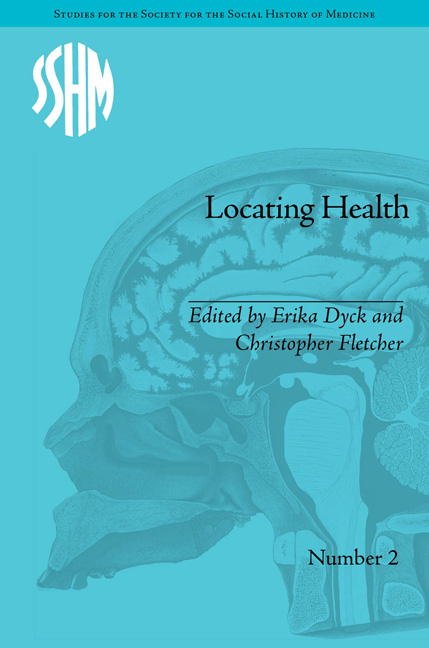Book contents
- Frontmatter
- CONTENTS
- List of Tables
- List of Contributors
- Acknowledgements and Preface
- Introduction: Healthscapes: Health and Place among and between Disciplines
- 1 Placing Maternal Health in India
- 2 Putting Medicine in its Place: The Importance of Historical Geography to the History of Health Care
- 3 Finding Place in The Big-Little World of Doc Pritham: Telling Medical Tales about Northwoods Maine, 1920s–70s
- 4 Putting Hyperactivity in its Place: Cold War Politics, the Brain Race and the Origins of Hyperactivity in the United States, 1957–68
- 5 Why Canada Has a Universal Medical Insurance Programme and the United States Does Not: Accounting for Historical Differences in American and Canadian Social Policies
- 6 Alberta Advantage: A Canadian Proving Ground for American Medical Research on Mustard Gas and Polio in the 1940s and 50s
- 7 Placing Illness in its Cultural Territory in Veracruz, Nicaragua
- 8 Chronic Disease in the Yukon River Basin, 1890–1960
- 9 An Ideal Home for the Consumptive: Place, Race and Tuberculosis in the Canadian West
- 10 Serbian Landscapes of Dreamtime and Healing: Clear Streams, Stones of Prophesy, St Sava's Ribs, and the Wooden City of Oz
- Notes
- Index
7 - Placing Illness in its Cultural Territory in Veracruz, Nicaragua
- Frontmatter
- CONTENTS
- List of Tables
- List of Contributors
- Acknowledgements and Preface
- Introduction: Healthscapes: Health and Place among and between Disciplines
- 1 Placing Maternal Health in India
- 2 Putting Medicine in its Place: The Importance of Historical Geography to the History of Health Care
- 3 Finding Place in The Big-Little World of Doc Pritham: Telling Medical Tales about Northwoods Maine, 1920s–70s
- 4 Putting Hyperactivity in its Place: Cold War Politics, the Brain Race and the Origins of Hyperactivity in the United States, 1957–68
- 5 Why Canada Has a Universal Medical Insurance Programme and the United States Does Not: Accounting for Historical Differences in American and Canadian Social Policies
- 6 Alberta Advantage: A Canadian Proving Ground for American Medical Research on Mustard Gas and Polio in the 1940s and 50s
- 7 Placing Illness in its Cultural Territory in Veracruz, Nicaragua
- 8 Chronic Disease in the Yukon River Basin, 1890–1960
- 9 An Ideal Home for the Consumptive: Place, Race and Tuberculosis in the Canadian West
- 10 Serbian Landscapes of Dreamtime and Healing: Clear Streams, Stones of Prophesy, St Sava's Ribs, and the Wooden City of Oz
- Notes
- Index
Summary
Introduction
It is now widely accepted in medical anthropology and in the social sciences in general, that illness is an embodied cultural experience. Thus, rather than being an objective entity hovering over our human consciousness, illness is a cultural category. Feminist scholars, sociologists, medical anthropologists and many other social scientists have powerfully illustrated how the influence of moral values and subjective meanings is regularly imposed on information that is often presented simply as biological facts. Furthermore, Good argues that disease, the presumably objective description of illness, belongs to the culture of biomedicine, and that ‘culture is not only a means of representing disease, but is essential to its very constitution as a human reality’. Illness belongs to the cultural territory where it is experienced and confronted by suffering bodies and treated by healers. Like any other cultural category, illness is culturally contingent; and therefore it is also a polysemic experience. Hence, due to its cultural contingency, depending on age, ethnicity, education, religion, social position, geographical origin, gender and place, people perceive, experience and configure illness in a multiplicity of fashions.
In this paper I examine the culturally contingent nature of illness in the context of place among the people of Veracruz del Zapotal, or Veracruceños, from the department of Rivas, in southwest Nicaragua. Veracruceños are a Spanish-speaking Indigenous community claiming to be descendents of the Nahua people who settled in the Isthmus of Rivas around ad 500, and came to be known as the Nicarao.
- Type
- Chapter
- Information
- Locating HealthHistorical and Anthropological Investigations of Place and Health, pp. 107 - 128Publisher: Pickering & ChattoFirst published in: 2014



